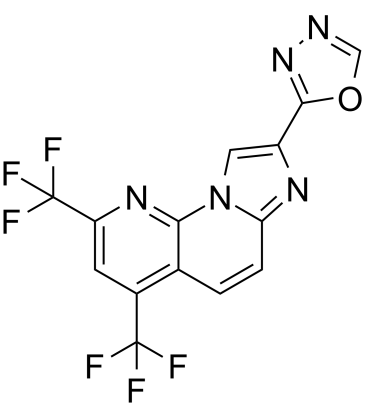RO8191
Modify Date: 2025-08-25 19:46:49

RO8191 structure
|
Common Name | RO8191 | ||
|---|---|---|---|---|
| CAS Number | 691868-88-9 | Molecular Weight | 373.21 | |
| Density | N/A | Boiling Point | N/A | |
| Molecular Formula | C14H5F6N5O | Melting Point | N/A | |
| MSDS | Chinese USA | Flash Point | N/A | |
| Symbol |

GHS06 |
Signal Word | Danger | |
Use of RO8191RO8191 (RO4948191), an imidazonaphthyridine compound, is an orally active and potent interferon (IFN) receptor agonist. RO8191 activates IFN-stimulated genes (ISGs) expression and JAK/STAT phosphorylation. RO8191 shows antiviral activity against both HCV and EMCV with an IC50 of 200 nM for HCV replicon[1]. |
| Name | RO8191 |
|---|---|
| Synonym | More Synonyms |
| Description | RO8191 (RO4948191), an imidazonaphthyridine compound, is an orally active and potent interferon (IFN) receptor agonist. RO8191 activates IFN-stimulated genes (ISGs) expression and JAK/STAT phosphorylation. RO8191 shows antiviral activity against both HCV and EMCV with an IC50 of 200 nM for HCV replicon[1]. |
|---|---|
| Related Catalog | |
| Target |
JAK1 IFNAR2 |
| In Vitro | RO8191 (RO4948191) exerts antiviral activity dependent on IFNAR2/JAK1, but is independent of IFNAR1/Tyk2. RO8191, an IFNAR2 agonist, stimulates IFN signals in mice[1]. RO8191 (0.08, 0.4, 2, 10 μM; for 72 h) strongly suppresses HCV replicon activity at 72 h in a dose-dependent manner. RO8191 reduces levels of the proteins HCV NS3 and NS4A, which are localized mainly in the perinuclear region of the replicon cells[1]. RO8191 (0.08-10 μM; for 72 h) results in the disappearance of viral proteins such as NS3, NS4A/B, and NS5A/B[1]. |
| In Vivo | RO8191 (RO4948191; 30 mg/kg; oral) significantly induces antiviral genes Oas1b, Mx1, and Pkr in the livers of six-week-old C57BL/6J mice[1]. |
| References |
| Molecular Formula | C14H5F6N5O |
|---|---|
| Molecular Weight | 373.21 |
| InChIKey | GRHYZVJEXKTJOS-UHFFFAOYSA-N |
| SMILES | FC(F)(F)c1cc(C(F)(F)F)c2ccc3nc(-c4nnco4)cn3c2n1 |
| Symbol |

GHS06 |
|---|---|
| Signal Word | Danger |
| Hazard Statements | H301 |
| Precautionary Statements | P301 + P310 |
| RIDADR | UN 2811 6.1 / PGIII |
| MFCD03102493 |